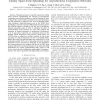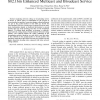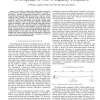144
Voted
VTC
2010
IEEE
14 years 11 months ago
2010
IEEE
— Adaptive network coded cooperation (ANCC) has been proposed as an effective scheme to combine network and channel coding for cooperative wireless networks by matching network-o...
109
Voted
VTC
2010
IEEE
14 years 11 months ago
2010
IEEE
—Game theory has been applied to model power control in wireless systems for years. Conventional power control games tend to consider unlimited backlogged user traffic. Differen...
87
Voted
VTC
2010
IEEE
14 years 11 months ago
2010
IEEE
Abstract—We evaluate the interference limited spectral efficiency of a small cellular network using measurements with 3 sites at an ISD of 750 m. Each 3-sector site is equipped ...
136
click to vote
VTC
2010
IEEE
14 years 11 months ago
2010
IEEE
—This paper proposes a cooperative space-time coding (STC) protocol, amalgamating the concepts of asynchronous cooperation, non-coherent detection as well as Distributed Turbo Co...
105
Voted
VTC
2010
IEEE
14 years 11 months ago
2010
IEEE
—Applying network coding on broadcasting service is known to reduce times of transmission in the process of recovering the loss packets. In previous design, coding coefficients ...
123
Voted
VTC
2010
IEEE
14 years 11 months ago
2010
IEEE
—Most of geographic routing approaches in wireless ad hoc and sensor networks do not take into consideration the medium access control (MAC) and physical layers when designing a ...
75
Voted
VTC
2010
IEEE
14 years 11 months ago
2010
IEEE
—This paper presents the results of an empirical study of wireless propagation channels for vehicle-to-vehicle communications in street intersections, a scenario especially impor...
122
Voted
VTC
2010
IEEE
14 years 11 months ago
2010
IEEE
—In this paper, we propose a new resource allocation scheme for an OFDMA relay network with multicells. In the proposed scheme, by sharing the channel state information (CSI) bet...
88
Voted
VTC
2010
IEEE
14 years 11 months ago
2010
IEEE
— Single carrier (SC) signal transmission has a property of low peak-to-average power ratio (PAPR) and achieves the frequency diversity gain by the use of frequency-domain equali...
107
Voted
VTC
2010
IEEE
14 years 11 months ago
2010
IEEE
Abstract—It is widely recognized that differential decode-andforward (DDF) cooperative transmission scheme is capable of providing a superior performance compared to classic dire...



